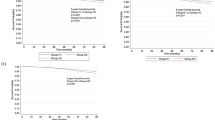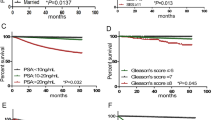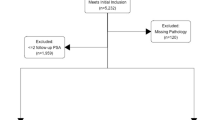Abstract
Background:
The value of radical prostatectomy (RP) as an approach for very high-risk prostate cancer (PCa) patients is controversial. To examine the risk of 10-year cancer-specific mortality (CSM) and other-cause mortality (OCM) according to clinical and pathological characteristics of very high-risk cT3b/4 PCa patients treated with RP as the primary treatment option.
Methods:
In a multi-institutional cohort, 266 patients with very high-risk cT3b/4 PCa treated with RP were identified. All patients underwent RP and pelvic lymph-node dissection. Competing-risk analyses assessed 10-year CSM and OCM before and after stratification for age and Charlson comorbidity index (CCI).
Results:
Overall, 34 (13%) patients died from PCa and 73 (28%) from OCM. Ten-year CSM and OCM rates ranged from 5.6% to 12.9% and from 10% to 38%, respectively. OCM was the leading cause of death in all subgroups. Age and comorbidities were the main determinants of OCM. In healthy men, CSM rate did not differ among age groups (10-year CSM rate for ⩽64, 65–69 and ⩾70 years: 16.2%, 11.5% and 17.1%, respectively). Men with a CCI ⩾1 showed a very low risk of CSM irrespective of age (10-year CSM: 5.6–6.1%), whereas the 10-year OCM rates increased with age up to 38% in men ⩾70 years.
Conclusion:
Very high-risk cT3b/4 PCa represents a heterogeneous group. We revealed overall low CSM rates despite the highly unfavorable clinical disease. For healthy men, CSM was independent of age, supporting RP even for older men. Conversely, less healthy patients had the highest risk of dying from OCM while sharing very low risk of CSM, indicating that this group might not benefit from an aggressive surgical treatment. Outcome after RP as the primary treatment option in cT3b/4 PCa patients is related to age and comorbidity status.
This is a preview of subscription content, access via your institution
Access options
Subscribe to this journal
Receive 4 print issues and online access
$259.00 per year
only $64.75 per issue
Buy this article
- Purchase on Springer Link
- Instant access to full article PDF
Prices may be subject to local taxes which are calculated during checkout


Similar content being viewed by others
References
Shao YH, Demissie K, Shih W, Mehta AR, Stein MN, Roberts CB, et al. Contemporary risk profile of prostate cancer in the united states. J Natl Cancer Inst 2009; 101: 1280–1283.
Heidenreich A, Bellmunt J, Bolla M, Joniau S, Mason M, Matveev V, et al. Eau guidelines on prostate cancer. Part 1: screening, diagnosis, and treatment of clinically localised disease. Eur Urol 2011; 59: 61–71.
Cooperberg MR, Cowan J, Broering JM, Carroll PR . High-risk prostate cancer in the united states, 1990–2007. World J Urol 2008; 26: 211–218.
Cooperberg MR, Vickers AJ, Broering JM, Carroll PR . Comparative risk-adjusted mortality outcomes after primary surgery, radiotherapy, or androgen-deprivation therapy for localized prostate cancer. Cancer 2010; 116: 5226–5234.
Gontero P, Marchioro G, Pisani R, Zaramella S, Sogni F, Kocjancic E, et al. Is radical prostatectomy feasible in all cases of locally advanced non-bone metastatic prostate cancer? Results of a single-institution study. Eur Urol 2007; 51: 922–929 discussion 929-930.
Joniau S, Hsu CY, Gontero P, Spahn M, Van Poppel H . Radical prostatectomy in very high-risk localized prostate cancer: long-term outcomes and outcome predictors. Scand J Urol Nephrol 2012; 46: 164–171.
Briganti A, Spahn M, Joniau S, Gontero P, Bianchi M, Kneitz B, et al. Impact of age and comorbidities on long-term survival of patients with high-risk prostate cancer treated with radical prostatectomy: a multi-institutional competing-risks analysis. Eur Urol 2013; 63: 693–701.
Akre O, Garmo H, Adolfsson J, Lambe M, Bratt O, Stattin P . Mortality among men with locally advanced prostate cancer managed with noncurative intent: a nationwide study in pcbase sweden. Eur Urol 2011; 60: 554–563.
Spahn M, Briganti A, Capitanio U, Kneitz B, Gontero P, Karnes JR, et al. Outcome predictors of radical prostatectomy followed by adjuvant androgen deprivation in patients with clinical high risk prostate cancer and pt3 surgical margin positive disease. J Urol 2012; 188: 84–90.
Briganti A, Joniau S, Gontero P, Abdollah F, Passoni NM, Tombal B, et al. Identifying the best candidate for radical prostatectomy among patients with high-risk prostate cancer. Eur Urol 2012; 61: 584–592.
Yossepowitch O, Eggener SE, Bianco FJ Jr ., Carver BS, Serio A, Scardino PT et al. Radical prostatectomy for clinically localized, high risk prostate cancer: Critical analysis of risk assessment methods. J Urol 2007; 178: 493–499; discussion 499.
Walz J, Joniau S, Chun FK, Isbarn H, Jeldres C, Yossepowitch O, et al. Pathological results and rates of treatment failure in high-risk prostate cancer patients after radical prostatectomy. BJU Int 2011; 107: 765–770.
Droz JP, Balducci L, Bolla M, Emberton M, Fitzpatrick JM, Joniau S, et al. Management of prostate cancer in older men: recommendations of a working group of the international society of geriatric oncology. BJU Int 2010; 106: 462–469.
Albertsen PC, Moore DF, Shih W, Lin Y, Li H, Lu-Yao GL . Impact of comorbidity on survival among men with localized prostate cancer. J Clin Oncol 2011; 29: 1335–1341.
Daskivich TJ, Fan KH, Koyama T, Albertsen PC, Goodman M, Hamilton AS, et al. Effect of age, tumor risk, and comorbidity on competing risks for survival in a U.S. population-based cohort of men with prostate cancer. Ann Intern Med 2013; 158: 709–717.
Studer UE, Whelan P, Albrecht W, Casselman J, de Reijke T, Hauri D, et al. Immediate or deferred androgen deprivation for patients with prostate cancer not suitable for local treatment with curative intent: European organisation for research and treatment of cancer (eortc) trial 30891. J Clin Oncol 2006; 24: 1868–1876.
Abdollah F, Sun M, Thuret R, Jeldres C, Tian Z, Briganti A, et al. A competing-risks analysis of survival after alternative treatment modalities for prostate cancer patients: 1988–2006. Eur Urol 2011; 59: 88–95.
Daskivich TJ, Litwin MS, Penson DF . Effect of age, tumor risk, and comorbidity in a U.S. Population-based cohort of men with prostate cancer. Ann Intern Med 2013; 159: 370.
Studer UE, Whelan P, Wimpissinger F, Casselman J, de Reijke TM, Knonagel H, et al. Differences in time to disease progression do not predict for cancer-specific survival in patients receiving immediate or deferred androgen-deprivation therapy for prostate cancer: final results of EORTC randomized trial 30891 with 12 years of follow-up. Eur Urol 2013; 66: 829–838.
Mottet N, Bellmunt J, Bolla M, Joniau S, Mason M, Matveev V, et al. [eau guidelines on prostate cancer. Part II: treatment of advanced, relapsing, and castration-resistant prostate cancer]. Acta Urol Esp 2011; 35: 565–579.
Engel J, Bastian PJ, Baur H, Beer V, Chaussy C, Gschwend JE, et al. Survival benefit of radical prostatectomy in lymph node-positive patients with prostate cancer. Eur Urol 2010; 57: 754–761.
Steuber T, Budaus L, Walz J, Zorn KC, Schlomm T, Chun F, et al. Radical prostatectomy improves progression-free and cancer-specific survival in men with lymph node positive prostate cancer in the prostate-specific antigen era: a confirmatory study. BJU Int 2011; 107: 1755–1761.
Author information
Authors and Affiliations
Corresponding author
Ethics declarations
Competing interests
The authors declare no conflict of interest.
Rights and permissions
About this article
Cite this article
Moltzahn, F., Karnes, J., Gontero, P. et al. Predicting prostate cancer-specific outcome after radical prostatectomy among men with very high-risk cT3b/4 PCa: a multi-institutional outcome study of 266 patients. Prostate Cancer Prostatic Dis 18, 31–37 (2015). https://doi.org/10.1038/pcan.2014.41
Received:
Revised:
Accepted:
Published:
Issue Date:
DOI: https://doi.org/10.1038/pcan.2014.41
This article is cited by
-
Evaluation of cystoprostatectomy on patients with prostate cancer extending to bladder: a retrospective study from single center
BMC Urology (2022)
-
Elderly patients aged ≥ 75 years with locally advanced prostate cancer may benefit from local treatment: a population-based propensity score-adjusted analysis
World Journal of Urology (2019)
-
Classifying high-risk versus very high-risk prostate cancer: is it relevant to outcomes of conformal radiotherapy and androgen deprivation?
Radiation Oncology (2017)
-
Radikale Prostatektomie beim klinisch lokal fortgeschrittenen Prostatakarzinom
Der Urologe (2017)
-
The survival impact of neoadjuvant hormonal therapy before radical prostatectomy for treatment of high-risk prostate cancer
Prostate Cancer and Prostatic Diseases (2017)



